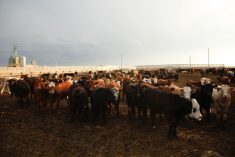Western Canadian feeder cattle prices were traded $15 to $25 below week-ago levels, suffering one of the largest declines in history.
Heavier replacement cattle led the market lower, trading down $20 from week-ago levels, while feeders under 600 pounds dropped $10 to $12 on average. Feedlot operators pulled in the reins, as fed cattle dropped nearly $10 in one week.
Alberta packers were buying fed cattle in the range of $168-$170, down from $180 in late September. We now find feeding margins in red ink by $250-$300 per head and cattle buyers appeared to throw in the towel, abandoning any hope of recovery. Certain feedlot operators were active scale-down buyers throughout the week, trying to average down earlier purchases. However, this seemed like a futile experience, with the week ending on a very soft tone. Market comments suggested some feedlots were not placing any orders until the market stabilized, which left fewer players in the arena. Lower-quality fleshier cattle were discounted an additional $8-$10 at times and the steer/heifer spread appeared to widen by $3-$6.
Read Also

Alberta crop conditions improve: report
Varied precipitation and warm temperatures were generally beneficial for crop development across Alberta during the week ended July 8, according to the latest provincial crop report released July 11.
The market was quite variable across the Prairies; Manitoba and Saskatchewan markets were rather tenacious, trading at a slight premium over Alberta markets. However, values of similar-quality cattle varied by $5-$10 in the same region. Medium-flesh mixed steers averaging 875 lbs. traded at $245 in central Alberta while mixed heifers weighing 885 lbs. traded for $230 in the same area. Larger-frame Charolais-cross lower-flesh steers averaging 700 lbs. were quoted at $270 landed in southern Alberta. Angus-cross heifers weighing just over 500 lbs. traded for $260 in central Alberta while similar cattle were quoted at $265 in southern Manitoba. Calves under 450 lbs. were down sharply, trading $20-$30 below week-ago levels. In declining markets, the longer feeding timeframe causes buyers to incorporate a risk discount, which was quite noticeable this past week.
Wholesale beef prices remain under pressure, with U.S. choice product actively trading at US$208/cwt, down from last week’s trade near US$219/cwt and sharply lower than year-ago levels of US$238/cwt.
The beef market moves through a period of seasonal low demand in October, but there is a fair amount of uncertainty given the weaker futures in the deferred positions. Packers have sufficient coverage for October and feedlots are anxious to move fed cattle in this declining market. Look for the downward trend in the feeder complex to continue until the beef market environment improves.
— Jerry Klassen is manager of the Canadian office for Swiss-based grain trader GAP SA Grains and Produits. He is also president and founder of Resilient Capital, which specializes in proprietary commodity futures trading and commodity market analysis. Jerry owns farmland in Manitoba and Saskatchewan but grew up on a mixed farm/feedlot operation in southern Alberta, which keeps him close to the grassroots level of grain and cattle production. Jerry is a graduate of the University of Alberta. He can be reached at 204-504-8339.














